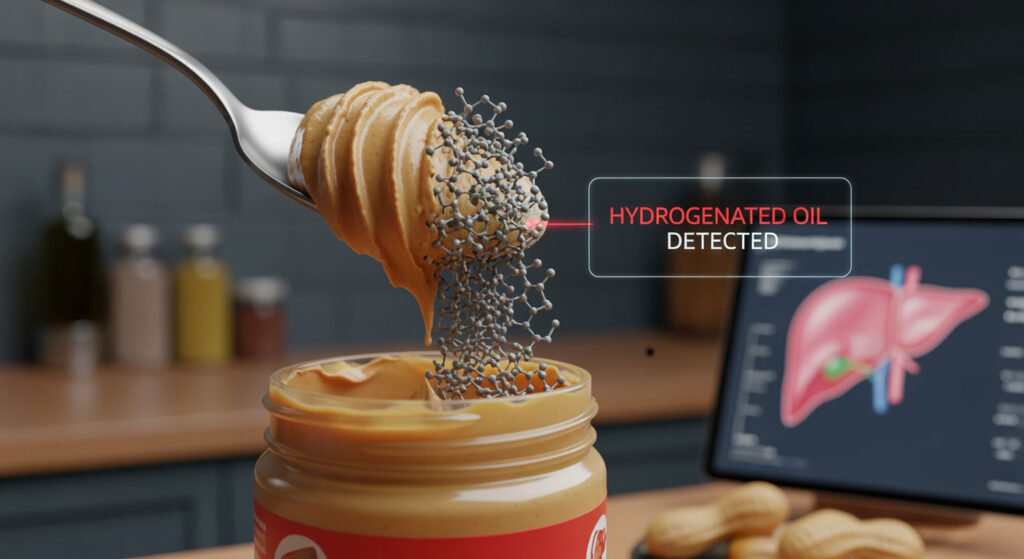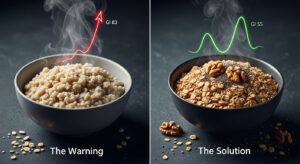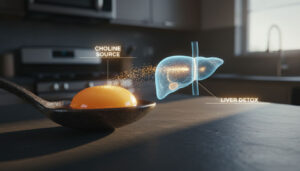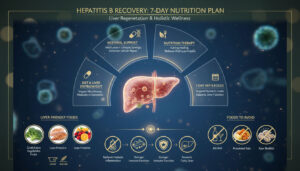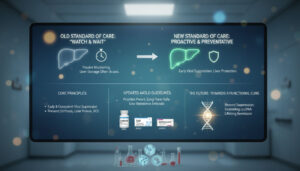Quick Verdict:Yes, peanut butter is safe for fatty liver (MASLD) if the ingredients are only Peanuts + Salt. You must avoid brands containing “Hydrogenated Oil” or “Added Sugar,” as these ingredients worsen insulin resistance. Limit consumption to 2 tablespoons per day to manage calories while maximizing therapeutic benefits.
Natural peanut butter is highly beneficial for fatty liver (MASLD) because it is rich in oleic acid and Vitamin E. These nutrients help reduce liver fat and inflammation. However, you must avoid brands containing hydrogenated oils (often labeled as stabilizers). These processed fats worsen insulin resistance and accelerate liver damage. The best peanut butter for fatty liver contains only peanuts and salt.
You probably have a jar sitting in your pantry right now. It is an American staple found in over 90 percent of households, synonymous with childhood lunches and quick snacks. Yet, for the estimated 100 million Americans managing liver health issues, this creamy comfort food is often a source of deep confusion and anxiety. When you receive a diagnosis related to liver health, the grocery store transforms from a place of abundance into a complex landscape of potential dietary pitfalls.
Table of Contents
The question “Is peanut butter good for your liver” does not have a simple yes or no answer because peanut butter is not a single, uniform product. It varies wildly depending on the manufacturer and the ingredients used. It depends entirely on the fine print of the ingredient label.
Peanuts themselves are medicinal powerhouses. They are legumes that behave like tree nuts, packed with the same heart-healthy, liver-supporting fats found in olive oil. They are ancient sources of nutrition that human bodies have thrived on for centuries.

However, the industrial processing methods used by major commercial brands can turn this superfood into a metabolic burden. By altering the chemical structure of the fats to increase shelf life, manufacturers inadvertently create a product that stresses the liver rather than healing it.
If you are navigating the MASLD diet food list (formerly known as the NAFLD diet), understanding the difference between a healing food and a harmful one is critical. This is not just about calories. It is about inflammation, cellular repair, and hormonal balance.
This comprehensive guide will break down exactly how peanut butter fatty liver protocols work. We will uncover the hidden ingredient that accelerates liver cell damage, explain the biochemistry of healing fats, and identify identify liver-safe peanut butter brands experts recommend. By the end of this article, you will have the knowledge to walk down the aisle with confidence, knowing exactly which jar belongs in your cart and which one belongs on the shelf.
Understanding the Liver-Fat Connection
To understand why specific fats matter, we must first update our terminology and understanding of the disease itself. The medical community is shifting from using the term Non-Alcoholic Fatty Liver Disease (NAFLD) to Metabolic Dysfunction-Associated Steatotic Liver Disease (MASLD).

This name change is significant. It is not just semantics. It highlights that the condition is driven by systemic metabolic issues like insulin resistance, visceral adiposity, and poor lipid handling. It moves the focus away from what you are not doing (drinking alcohol) and places it on what is physiologically happening inside your metabolic engine.
The Role of Dietary Fats in Hepatic Steatosis
A common misconception that persists from the low-fat diet trends of the 1990s is that eating fat directly leads to a fatty liver. This is physiologically inaccurate and can lead patients to avoid foods that would actually help them heal.
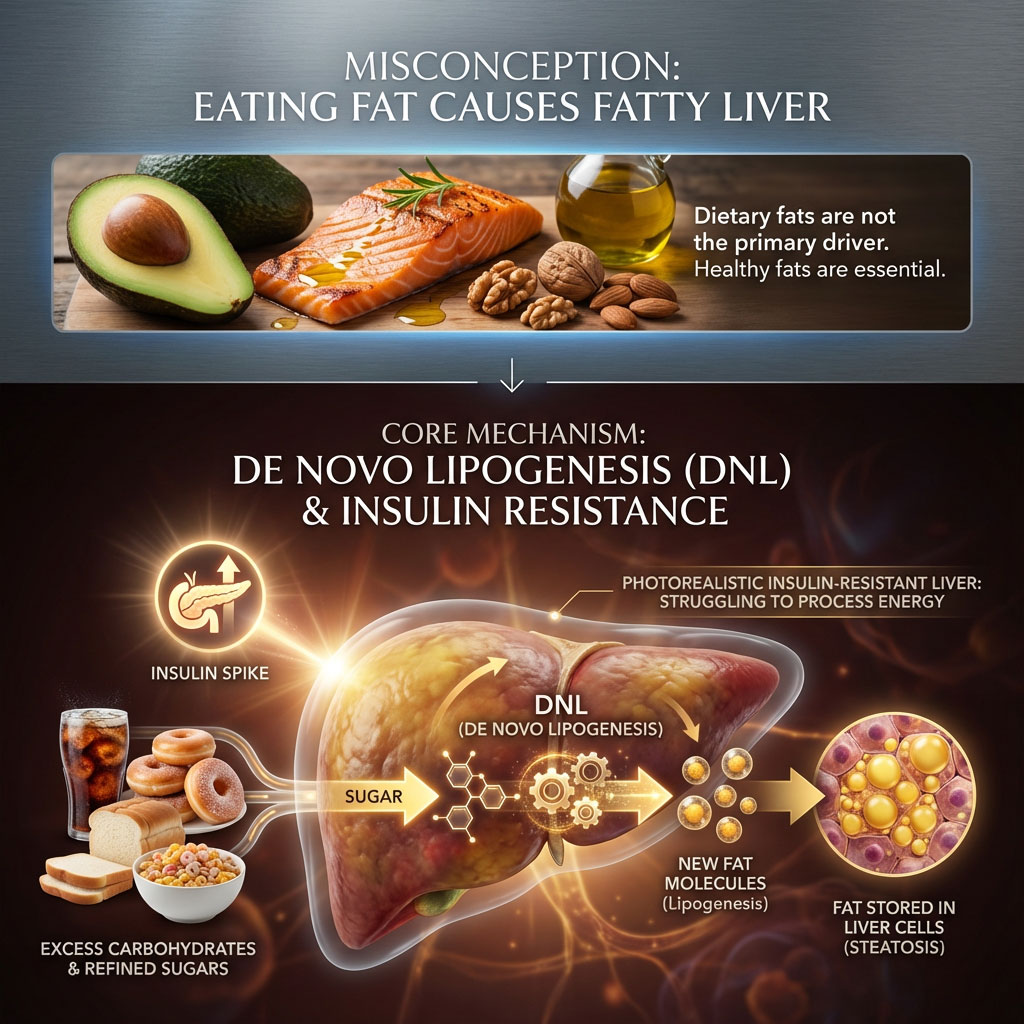
Hepatic steatosis (fat accumulation in liver cells) is primarily driven by a process called De Novo Lipogenesis.
This process occurs when the liver converts excess carbohydrates and refined sugars into fat. When you consume high-glycemic foods, insulin levels spike. If the liver is already insulin resistant, it cannot process this energy effectively. Instead, it takes that sugar and synthesizes new fat molecules, storing them directly within the liver tissue.
Visualizing the Mechanism: De Novo Lipogenesis vs. Healthy Fat Metabolism
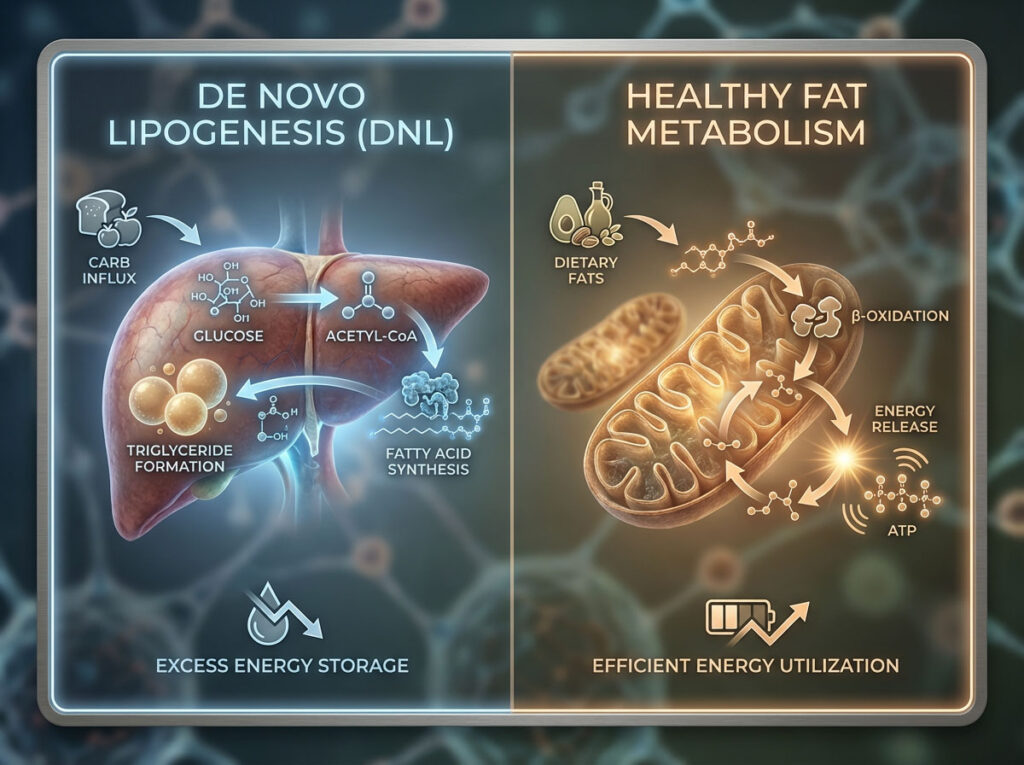
To better understand why sugar and trans fats are the real culprits, consider the following metabolic flow:
| Pathway A: The Metabolic Stressor (Sugar/Refined Carbs) | Pathway B: The Therapeutic Agent (Natural Fats/Peanuts) |
| 1. Input: Refined Sugar / High Fructose Corn Syrup | 1. Input: Monounsaturated Fats (Oleic Acid) |
| 2. Hormonal Response: Massive Insulin Spike | 2. Hormonal Response: Minimal Insulin Impact |
| 3. Liver Action: Converts sugar to Palmitic Acid (Saturated Fat) | 3. Liver Action: Oxidizes fat for energy or exports it |
| 4. Outcome: De Novo Lipogenesis (New Fat Creation) | 4. Outcome: Reduced Inflammation & Improved Lipid Profile |
| 5. Result: Increased Hepatic Steatosis | 5. Result: Hepatocyte Repair |
In fact, healthy fats for liver repair are essential for reversing the damaging process shown in Pathway A. Monounsaturated fats (MUFA) found in nuts, seeds, and avocados act as signaling molecules. They help the liver export fat and reduce inflammation. They provide a slow-burning fuel source that does not spike insulin, giving the liver a break from the constant sugar-processing workload.
However, not all fats behave this way. The biological geometry of the fat molecule matters.
While unsaturated fats act as medicine, trans fats liver damage is a well-documented biological reality. Trans fats and hydrogenated oils are molecularly rigid. When incorporated into your cell membranes, they stiffen the cell walls. This blockage makes it difficult for insulin receptors to function.
This creates a cycle of metabolic dysfunction. The liver becomes more insulin resistant. It stops burning fat for energy. It starts storing fat instead. The more fat it stores, the more inflamed it becomes.
Therefore, asking “Is peanut butter safe for people with fatty liver disease?” requires us to look closely at the type of fat inside the jar. We must determine if the fat will make the cell membrane fluid and functional, or rigid and dysfunctional.
The “Hidden Ingredient”: Why Commercial Brands Are Metabolically Disruptive
The primary reason some peanut butters are classified as foods to avoid with fatty liver is one specific, pervasive additive: Hydrogenated Vegetable Oil.

Commercial manufacturers add fully or partially hydrogenated oils (typically rapeseed, soybean, or cottonseed) to their products. This is a chemical process where hydrogen gas is forced into liquid vegetable oil under high pressure.
They do this for two reasons. First, it prevents the natural oil from separating and rising to the top. Second, it creates a perfectly smooth, homogenous texture that does not require stirring and spreads easily on soft bread.
While this is convenient for making sandwiches, it is highly detrimental to your metabolic health. It transforms a natural, fluid fat into a solid, artificial fat that the body struggles to process.
How Hydrogenated Oils Accelerate Liver Damage
Hydrogenated oils liver damage occurs through specific biological mechanisms that attack the liver from multiple angles.

First, these oils trigger systemic inflammation. When consumed, these artificial lipids can irritate the lining of the gut. This stress travels up the gut-liver axis (the direct blood supply link between the intestines and the liver) and signals the liver to release inflammatory markers. This state of chronic low-grade inflammation is the precursor to fibrosis.
Second, these processed fats are difficult for hepatocytes (liver cells) to metabolize. The liver is the body’s primary filtration and detoxification organ. It is designed to break down natural fats found in nature.
Unlike natural oleic acid, which the liver burns easily for energy, hydrogenated fats promote oxidative stress. They are molecularly awkward for the liver’s enzymes to break down.
This metabolic struggle contributes to oxidative stress within the liver cells. This stress damages the mitochondria within liver cells. The mitochondria are the power plants of your cells, responsible for burning fat. When they fail or become sluggish due to oxidative damage, fat accumulation accelerates.
The Sugar Trap
There is another compromising factor hiding in the jar alongside the bad fats.
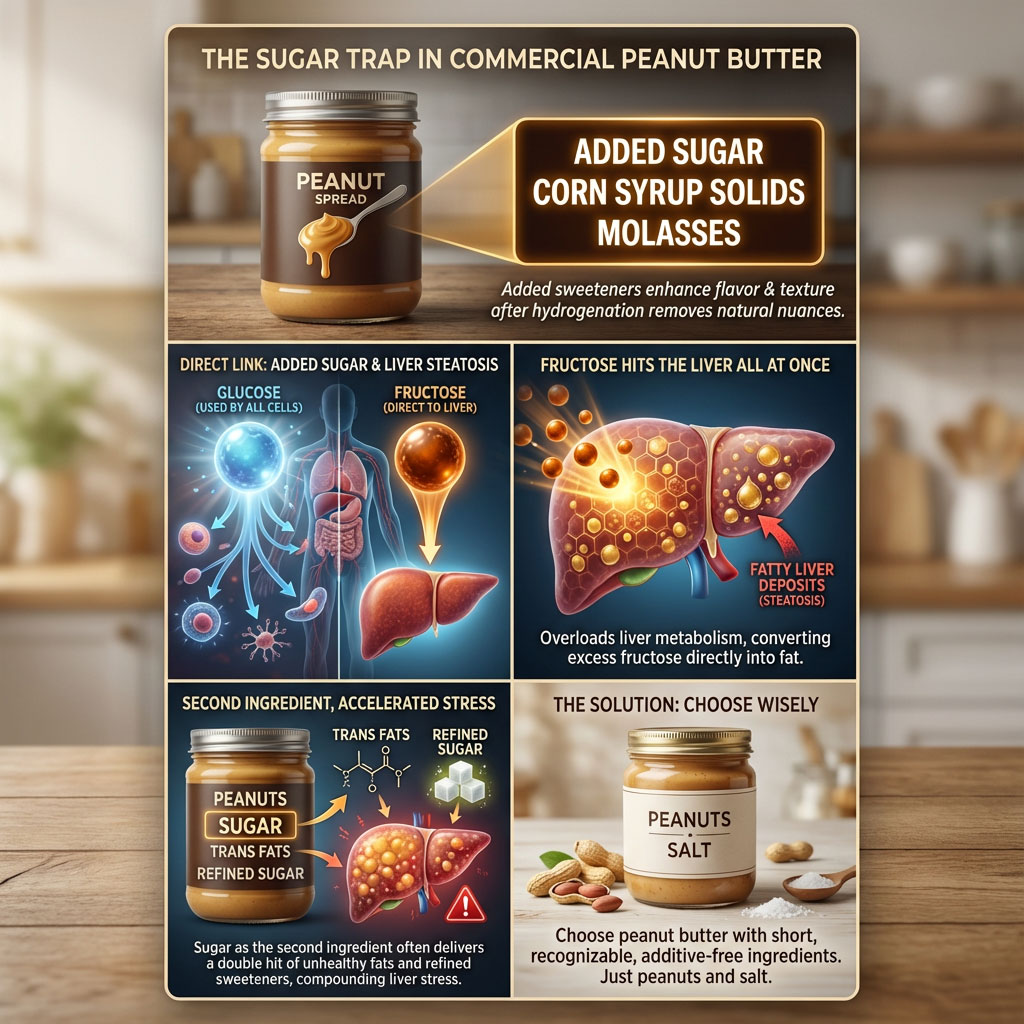
Standard versions of popular commercial brands often contain added sugar, corn syrup solids, or molasses. Manufacturers add these to enhance palatability, as the hydrogenation process can sometimes dampen the natural peanut flavor.
Added sugar and liver steatosis are directly linked. Fructose is a primary driver of liver fat. Unlike glucose, which can be used by every cell in the body for energy, fructose is primarily metabolized by the liver.
When you consume fructose in liquid or added form, it hits the liver all at once. If your peanut butter contains sugar as the second ingredient, it is fueling the very condition you are trying to reverse. You are essentially consuming a “healthy” protein source that has been contaminated with the two things your liver tolerates least: trans fats and refined sugar.
For optimal peanut butter liver health, the ingredient list must be short, recognizable, and devoid of these industrial additives.
Comparison: Natural vs. Processed (The Brand Safety Guide)

Distinguishing between natural peanut butter vs Jif or other commercial brands is the most important step you can take in this dietary adjustment. It is the difference between a therapeutic food and a metabolic stressor.
You do not need a degree in nutrition to spot the difference. You just need to perform the “Oil Separation Test.”
The “Oil Separation” Test
When you open a jar of natural peanut butter, you should see a pool of oil sitting on top of the nut paste.
Many consumers find this annoying. It requires effort to mix. It can be messy. However, for your liver, this pool of oil is a badge of honor. It is a visual guarantee of purity.

This separation proves that the product lacks emulsifiers. It means the manufacturer did not add hydrogenated oils to chemically bind the mixture. It means the fat structure is intact and natural.
That oil is pure peanut oil. It is rich in monounsaturated fats (MUFA). It is the “liquid gold” that will help heal your cellular membranes.
If you open a jar and the surface is perfectly smooth, stiff, and dry, be cautious. That texture is artificially created by hydrogenated fats. It is a sign that the product has been chemically engineered for shelf stability rather than biological compatibility.
How to Read the Label
To find liver-safe peanut butter brands specialists approve of, ignore the marketing on the front of the jar. Phrases like “All Natural” or “No High Fructose Corn Syrup” can be misleading. Flip the jar over and look at the ingredient statement.
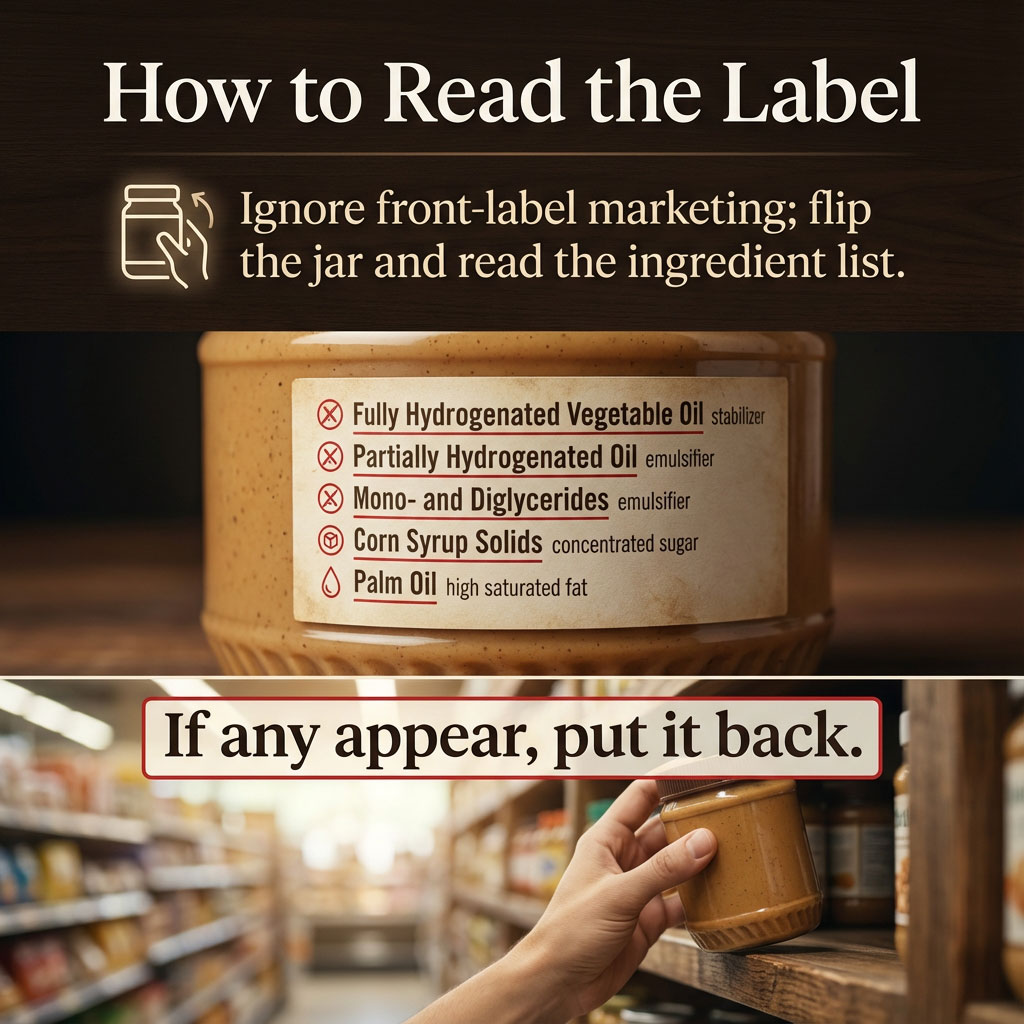
Scan for these specific red flags:
- Fully Hydrogenated Vegetable Oil: This is the most common stabilizer.
- Partially Hydrogenated Oil: Even rarer now due to FDA bans, but still lurking in some imports or older formulations.
- Mono- and Diglycerides: These are emulsifiers that can contain small amounts of trans fats but are often labeled as “fat replacers.”
- Corn Syrup Solids: A concentrated form of sugar.
- Palm Oil: While natural, it is high in saturated fat and often harvested unsustainably. For fatty liver, unsaturated fats are superior to the saturated fats found in palm oil.
If you see any of these, put it back.
Below is a detailed comparison to help you make the right choice at the grocery store.
Comparison: Commercial vs. Liver-Safe Peanut Butter
| Feature | Commercial Brands (e.g., Jif, Skippy) | Natural Brands (e.g., Crazy Richard’s, Smucker’s) |
| Primary Ingredient | Peanuts, Sugar, Hydrogenated Oils | Peanuts, Salt (Optional) |
| Hidden Ingredient | Fully Hydrogenated Rapeseed/Soybean Oil | None |
| Texture | Smooth, No-Stir (Artificial) | Separated Oil Layer (Natural) |
| Liver Impact | Increases Inflammation & Insulin Resistance | Reduces Liver Fat (Oleic Acid) |
| Sugar Content | 3–5g Added Sugar per serving | 0g Added Sugar |
| Vitamin E Bioavailability | Low (blocked by processed fats) | High (naturally preserved) |
| Gut Health | Irritates gut lining (Emulsifiers) | Supports microbiome (Fiber) |
| Glycemic Impact | Moderate (due to added sugar) | Low (Minimal insulin spike) |
The Science of Healing: Nutrients in Peanuts
When you choose the right product, peanut butter fatty liver benefits are significant. It stops being a “cheat food” and becomes a functional food.
Peanuts are technically legumes. However, their nutritional profile mimics that of tree nuts like walnuts and almonds. They are dense with nutrients that directly target the mechanisms of liver disease.
High Oleic Peanuts Benefits
The star nutrient in peanuts is oleic acid. This is the same monounsaturated fat found in olive oil and avocados, staples of the Mediterranean diet.
A 2024 study published in the Journal of Hepatology highlights the efficacy of high-oleic diets and metabolic regulation in managing steatotic liver disease. The research indicates that diets high in oleic acid can improve lipid profiles in patients with metabolic syndrome by influencing how the liver processes and exports fat.
This fat helps the liver regulate cholesterol. It encourages the liver to export VLDL particles (Very Low-Density Lipoproteins) rather than storing them within the liver tissue. It effectively helps “unclog” the fat accumulation in the hepatocytes.
Consequently, consuming peanut butter liver health friendly options can lower triglycerides, which are often dangerously high in MASLD patients.
The Vitamin E Connection
Liver inflammation causes scarring. When liver cells are injured by fat and inflammation, they try to heal. If the injury is constant, this healing results in scar tissue, known as fibrosis. Fibrosis is the bridge between fatty liver and cirrhosis.
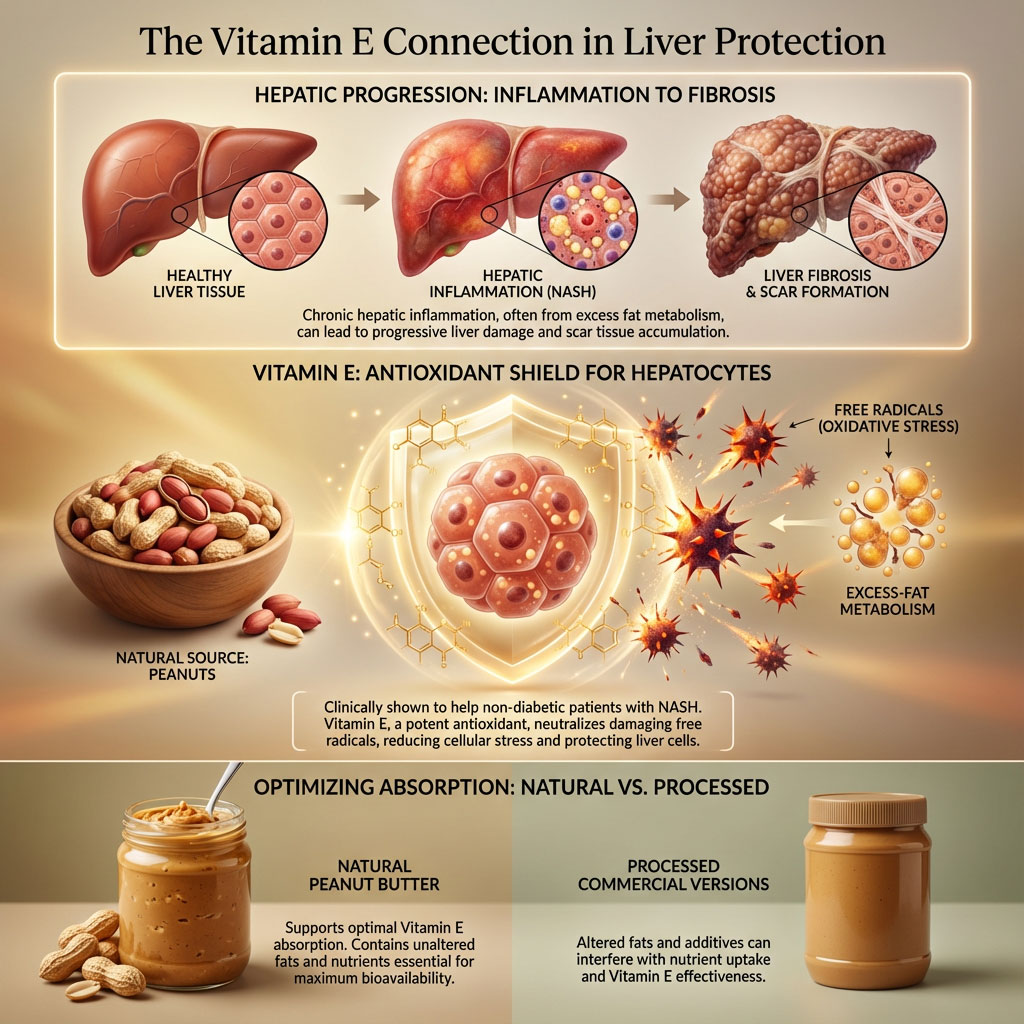
Vitamin E is a potent antioxidant that fights this process. It is one of the few supplements clinically proven to help non-diabetic patients with NASH (the severe form of fatty liver).
Peanuts are an excellent source of dietary Vitamin E. It protects the cell membranes of hepatocytes from oxidative damage. It acts as a shield, neutralizing free radicals that are produced when the liver metabolizes excess fat.
By choosing natural brands, you ensure maximum absorption of this vitamin. Processed fats in commercial brands can interfere with nutrient absorption, rendering the Vitamin E less effective.
Resveratrol and Plant Sterols
Peanuts contain Resveratrol. This is the bioactive compound often associated with red wine and longevity.
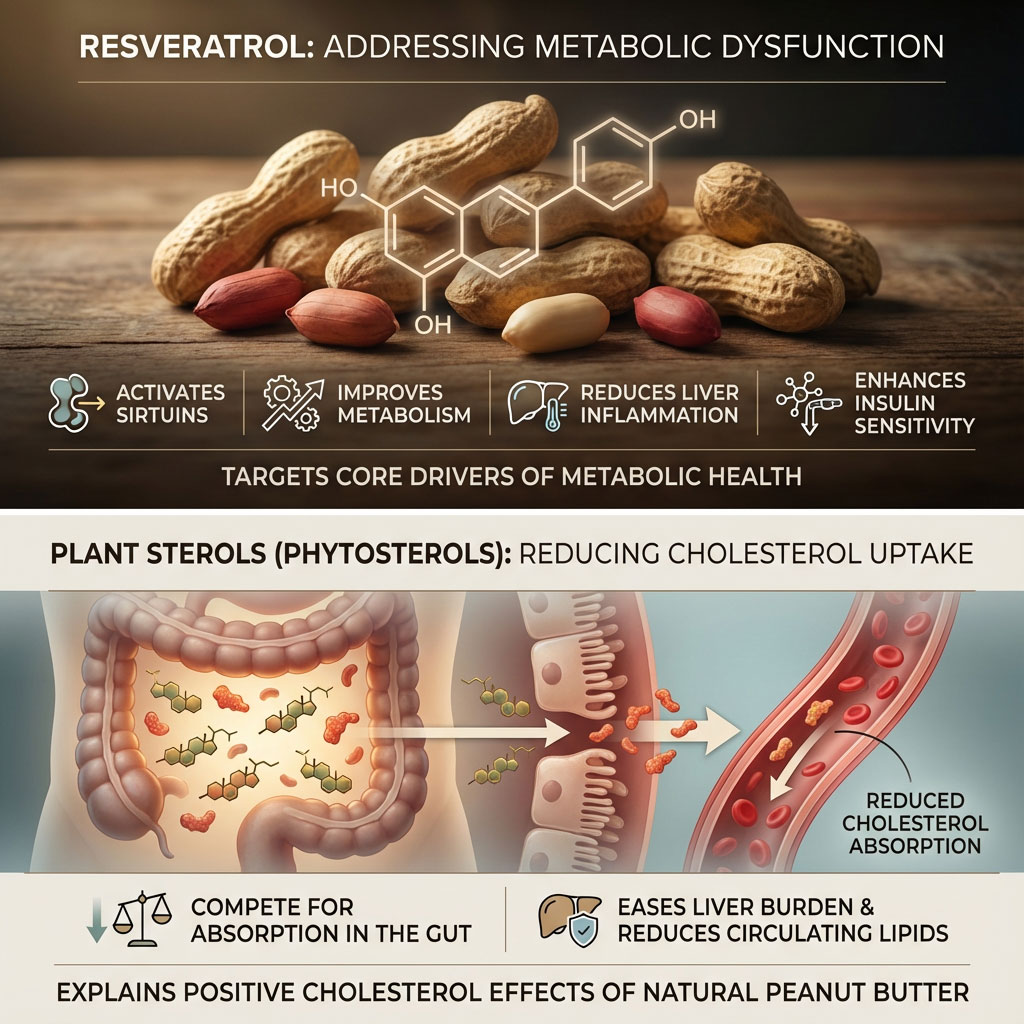
Resveratrol liver benefits include activating specific proteins called sirtuins that improve metabolism. It helps reduce liver inflammation and improves insulin sensitivity, addressing the root cause of the disease.
Additionally, peanuts contain plant sterols (phytosterols). These compounds look structurally similar to cholesterol. When you eat them, they compete with cholesterol for absorption in the gut.
This explains why peanut butter cholesterol effects are generally positive, provided the peanut butter is natural. By blocking cholesterol absorption, plant sterols help lower circulating blood lipids, taking pressure off the liver.
Advanced Safety: Aflatoxins and Mold
There is a deeper layer to peanut safety that rarely gets discussed in general health articles. It concerns a mold toxin called Aflatoxin B1.
Peanuts grow underground. Their shells are porous and absorb moisture from the soil. In humid climates, they can develop a mold called Aspergillus flavus. This mold produces aflatoxins, which are potent liver toxins.
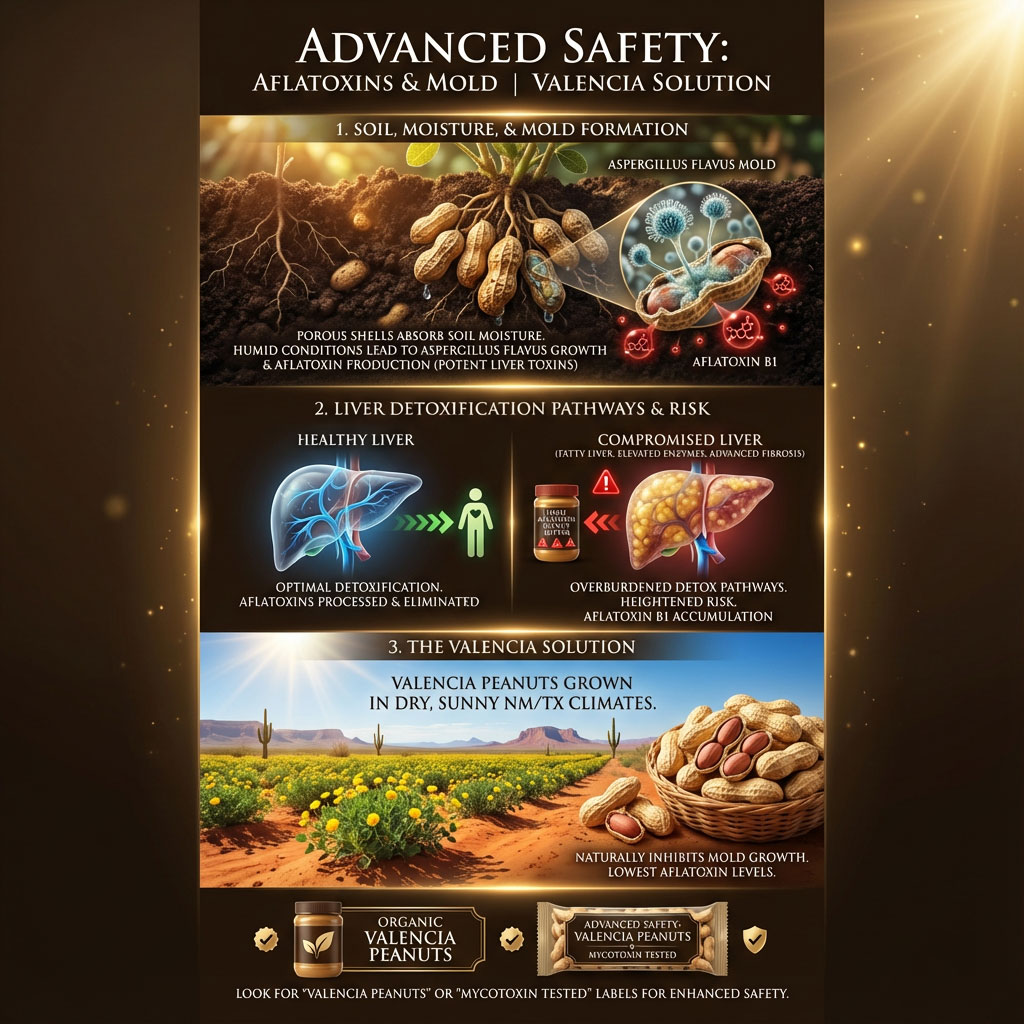
For a healthy person with a robust liver, the body detoxifies small amounts of aflatoxins easily. The liver breaks them down and excretes them.
However, for someone with peanut butter fatty liver concerns, the liver is already under significant stress. The detoxification pathways may be compromised or overburdened. Adding a toxin, even in micro-doses, can be counterproductive.
Aflatoxin peanut butter liver risk is a valid concern for those with significantly elevated liver enzymes or advanced fibrosis.
The Valencia Solution
You do not have to stop eating peanuts to avoid this risk. You simply need to change your source. The geography of where the peanut was grown matters.
Valencia peanuts are primarily grown in New Mexico and parts of Texas. The climate there is dry, arid, and sunny.
This dry climate naturally inhibits the growth of mold. The fungus cannot survive in the desert-like conditions. Therefore, Valencia peanuts have the lowest rates of aflatoxin contamination of any peanut variety.
Many organic brands source Valencia peanuts for this reason. They are sweeter, smaller, and safer.
Checking the label for “Valencia Peanuts” or buying from brands that explicitly test for mycotoxins is an advanced strategy for minimizing liver stress while maximizing nutrition.
Practical Strategy: Dosage, Diet & Alternatives
Even the healthiest food can be harmful if consumed in excess. The principle of hormesis applies here: the right dose is medicinal, but the wrong dose is poisonous.
Peanut butter is calorie-dense. Weight loss is the primary treatment for MASLD. Losing just 10 percent of your body weight can clear significant amounts of fat from the liver. Therefore, portion control is non-negotiable.
How Much Peanut Butter is Safe?
The most common question patients ask is: “How much peanut butter is safe to eat if you have a fatty liver?“
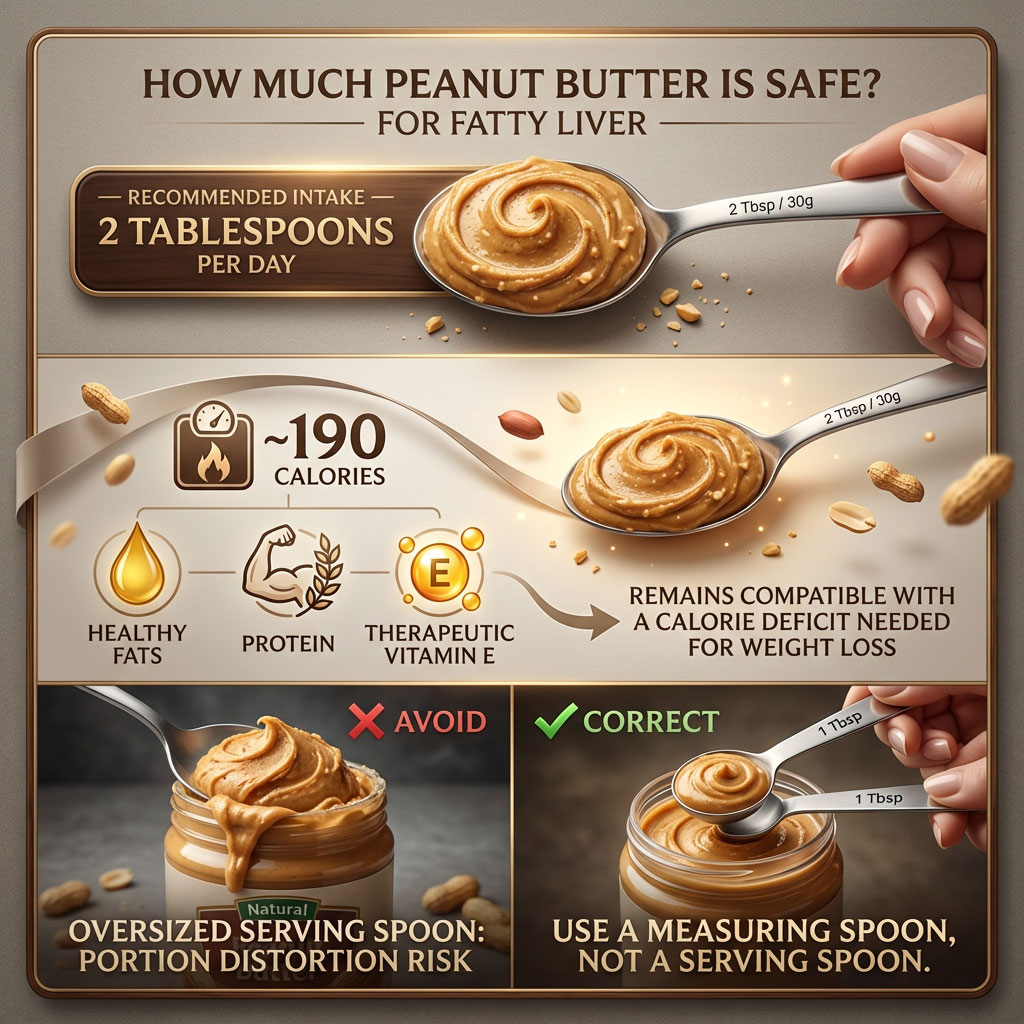
The recommended dosage is 2 tablespoons per day.
This amount provides approximately 190 calories. It delivers enough healthy fats and protein to induce satiety and provide therapeutic levels of Vitamin E. However, it is not enough to disrupt a calorie deficit required for weight loss.
Measuring your portion is crucial. Eating directly from the jar often leads to “portion distortion,” where you might unknowingly consume double or triple the intended amount. Use a measuring spoon, not a serving spoon.
Integrating into the MASLD Diet
The MASLD diet food list emphasizes the Mediterranean approach. This is widely considered the gold standard for liver health.
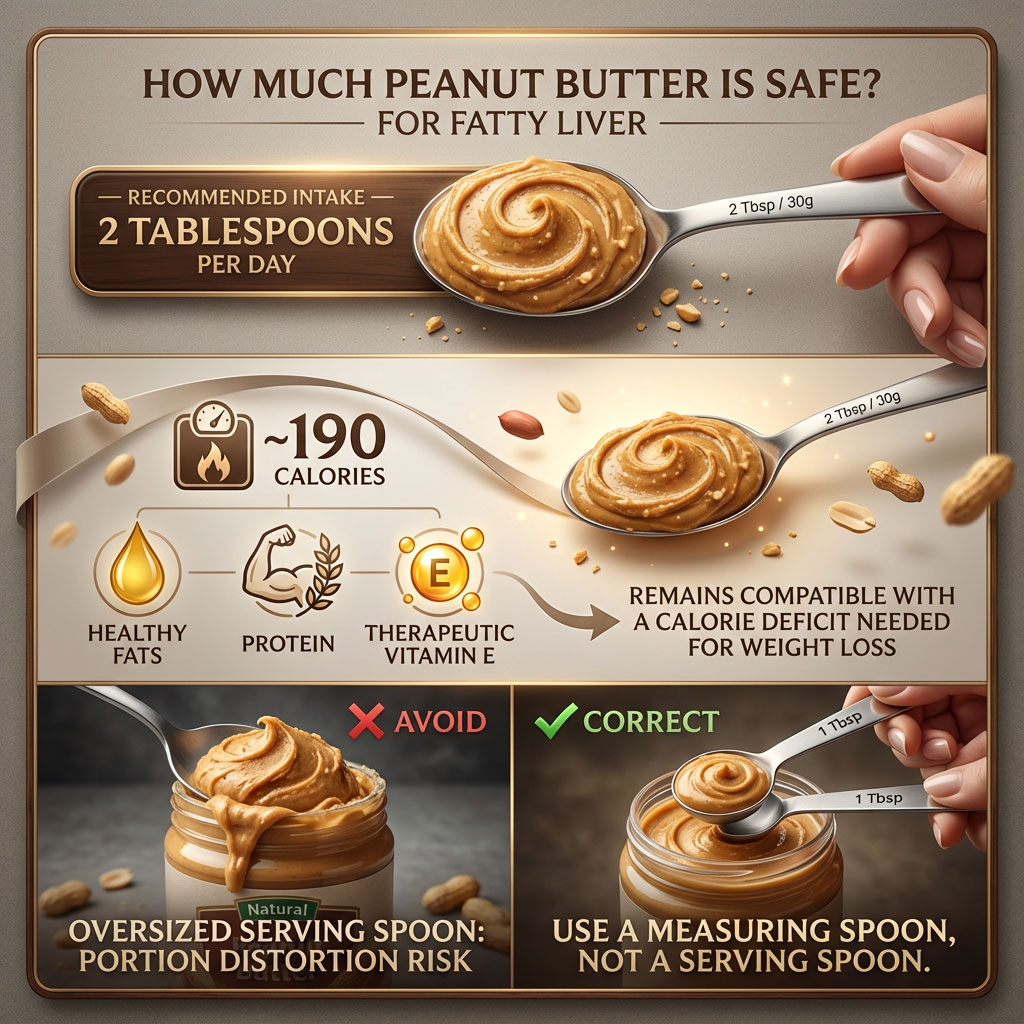
This diet focuses on whole grains, vegetables, lean proteins, and healthy fats. Natural peanut butter fits perfectly here, acting as a healthy fat source similar to olive oil.
Here are specific ways to integrate it:
- The Breakfast Boost: Stir a tablespoon into steel-cut oats. The fat and protein will slow down the absorption of carbohydrates from the oats, preventing a blood sugar spike.
- The Apple Snack: Spread it on apple slices. The pectin in apples helps gut health, while the peanut butter provides satiety.
- The Smoothie Stabilizer: Add a spoonful to a green smoothie to ensure the fat-soluble vitamins (Vitamin A, K) in the spinach are actually absorbed by your body.
Avoid eating it on white bread or with sugary jelly. The combination of refined carbs (bread) and simple sugar (jelly) spikes insulin dramatically. This hormonal spike negates the benefits of the healthy fats and promotes fat storage.
Substitutes and Alternatives
Sometimes peanuts are not the best option due to allergies, personal preference, or specific dietary protocols like the Autoimmune Protocol (AIP).

Comparing almond butter vs peanut butter liver benefits reveals that almond butter is slightly superior in nutrient density.
Almond butter contains more Vitamin E per serving than peanut butter. It also has a slightly better ratio of omega-6 to omega-3 fatty acids, which can be beneficial for reducing inflammation.
However, almond butter is significantly more expensive, often double or triple the price. Natural peanut butter remains the most cost-effective option for liver health, making it accessible for long-term adherence.
Another option is PB2 or powdered peanut butter.
Does powdered peanut butter (PB2) work for a fatty liver diet? Yes.
PB2 is created by pressing the peanuts to remove most of the oil. This lowers the calorie count significantly (usually 45 calories per serving vs 190). You lose some of the beneficial oleic acid, but you keep the protein and fiber. It is a safe, low-calorie alternative for those who are strictly restricting calories for rapid weight loss.
Comparison: Nut Butter Alternatives for Fatty Liver
| Nut Butter Type | Liver Benefit | Best For… | Watch Out For… |
| Natural Peanut Butter | High Oleic Acid, Resveratrol | General Liver Health & Budget | Aflatoxins (buy Valencia) |
| Almond Butter | Highest Vitamin E, Omega-3s | Reducing Inflammation | High Oxalates (Kidney Stones) |
| Sunflower Butter | High Vitamin E, Nut-Free | School Safe / Allergies | Added Sugar (often high) |
| Cashew Butter | Lower Fat, Creamy | Taste Preference | Higher Carb Count |
| Powdered PB (PB2) | High Protein, Low Calorie | Weight Loss Focus | Added Sugar in some versions |
Case Studies & Real Data
Understanding the theory is helpful, but seeing the results in real-world scenarios confirms the validity of the approach.
Clinical studies published in major nutrition journals consistently support nut consumption. Research involving over 25,000 participants has shown that high intake of nuts is associated with a lower prevalence of NAFLD
Patient Scenario: The Lipid Shift
Consider a hypothetical patient scenario that reflects common clinical outcomes. Let us call him Mark, a 45-year-old office worker diagnosed with early-stage fatty liver and high triglycerides.
Mark’s typical breakfast was two slices of white toast with a generous spread of standard Skippy peanut butter and strawberry jam. He felt sluggish by mid-morning and struggled with brain fog.
His doctor advised him to switch to the Mediterranean diet peanut butter protocol.
Mark made three specific changes:
- He switched from white bread to sprouted grain bread.
- He replaced the commercial peanut butter with a natural brand containing only peanuts and salt.
- He eliminated the jam and replaced it with sliced bananas or a dash of cinnamon.
- He strictly limited his intake to 2 measured tablespoons.
After 90 days, Mark returned for follow-up blood work. The results showed a clear metabolic shift.
His LDL cholesterol dropped by 15 points. His triglycerides, which were previously elevated, decreased significantly. Most importantly, his liver inflammation markers (ALT and AST enzymes) began to normalize, trending downward toward the healthy range.
This improvement was not magic. It was biochemistry. It was the result of removing the hydrogenated oils liver damage triggers and introducing healing oleic acid and Vitamin E. By removing the inflammatory insult (trans fats and sugar) and providing the raw materials for repair (healthy fats), his liver was given the opportunity to heal itself.
Summary & Key Takeaways
The journey to reversing fatty liver is about consistency, quality, and understanding that food is information for your cells. Every bite tells your liver what to do: burn fat or store it, heal or inflame.
To answer the core question: Is peanut butter good for your liver?
Yes. It is a powerful ally. But you must be vigilant.
Here is your final checklist for the grocery store to ensure you are buying medicine, not poison:
- Read the Ingredients: It should list “Peanuts” and maybe “Salt.” Nothing else. No unpronounceable words.
- The Shake Test: If the oil does not move inside the jar when you tilt it, do not buy it. Stiffness equals stabilizers.
- Avoid Hydrogenated Oils: These are the primary cause of peanut butter liver health issues in processed brands. They are non-negotiable avoids.
- Watch the Sugar: Ensure there is 0g of added sugar. Your liver does not need the extra fructose load.
- Mind the Dosage: Stick to 2 tablespoons daily to manage calories while maximizing nutrient intake.
- Consider Source: If possible, look for Valencia peanuts to minimize mold toxins.
By making this simple switch, you turn a daily snack into a tool for metabolic healing. You take control of your health, one tablespoon at a time.
Frequently Asked Questions (FAQ)
Is peanut butter safe for people with fatty liver disease?
Yes, natural peanut butter is safe and recommended. It contains monounsaturated fats (MUFA) which act as signaling molecules to help reduce liver fat. However, you must ensure the brand does not contain added sugar or hydrogenated oils, as these additives can worsen the condition.
Which peanut butter brands avoid hydrogenated oils?
Brands that typically avoid these oils include Crazy Richard’s, Smucker’s Natural, Santa Cruz Organic, 365 Everyday Value (Whole Foods), and Justin’s. Always flip the jar and check the label to ensure it only lists “peanuts” and “salt” as ingredients.
Does peanut butter cause high liver enzymes?
Natural peanut butter does not cause high liver enzymes. In fact, the healthy fats may help lower them over time. However, processed brands loaded with trans fats and high sugar can contribute to liver inflammation, which may lead to elevated ALT and AST levels.
Is Jif peanut butter bad for fatty liver?
Standard Jif contains fully hydrogenated vegetable oils, mono- and diglycerides, and added sugar. These ingredients are foods to avoid with fatty liver because they promote insulin resistance. Jif Natural is a better alternative but still requires checking the label carefully for added sugar or palm oil.
Why does my liver hurt after eating peanut butter?
If you feel pain in the upper right abdomen immediately after eating fats, it may be a gallbladder issue (like gallstones) rather than the liver itself. The liver does not have pain receptors, but the capsule around it does. A fatty meal triggers the gallbladder to contract; if stones are present, this causes pain. Consult a doctor if this occurs.
Can peanut butter help lower bad cholesterol and support liver?
Yes. The oleic acid in peanuts helps lower LDL (bad) cholesterol while maintaining or boosting HDL (good) cholesterol. Improving your lipid profile reduces the metabolic burden on the liver and lowers the risk of cardiovascular complications associated with MASLD.
Is almond butter better than peanut butter for fatty liver?
Almond butter is slightly better due to higher Vitamin E content and a better Omega-3 to Omega-6 ratio. It is also lower in saturated fat. However, natural peanut butter is still an excellent, highly effective, and affordable choice for liver health.
Does powdered peanut butter (PB2) work for a fatty liver diet?
Yes. PB2 is a great option for those strictly counting calories or those who need to lose weight rapidly. It provides protein and peanut flavor without the calorie density of the full oil content. It is versatile for smoothies and baking.
What hidden ingredients in peanut butter harm the liver?
The most harmful ingredients are hydrogenated vegetable oils (trans fats), palm oil, high fructose corn syrup, molasses, and mono- and diglycerides. These contribute to systemic inflammation, insulin resistance, and fat storage.
How do hydrogenated oils cause liver damage?
Hydrogenated oils stiffen cell membranes, causing systemic inflammation and impairing insulin sensitivity. This forces the liver to store more fat via de novo lipogenesis and hinders the mitochondria’s ability to burn fat for fuel, worsening the condition.
Can I eat peanut butter if I have elevated ALT/AST?
Yes, but it must be natural. The antioxidants in peanuts, such as Vitamin E and Resveratrol, can actually help lower inflammation and support liver repair over time. Combine it with a high-fiber diet for the best results.
Is organic peanut butter necessary for liver detox?
Organic is preferred to avoid pesticide residues and minimize Aflatoxin peanut butter liver risk. Since the liver is the body’s detox organ, reducing the toxic load from pesticides helps it focus on healing itself. However, conventional natural peanut butter is still significantly better than processed organic peanut butter containing sugar.

